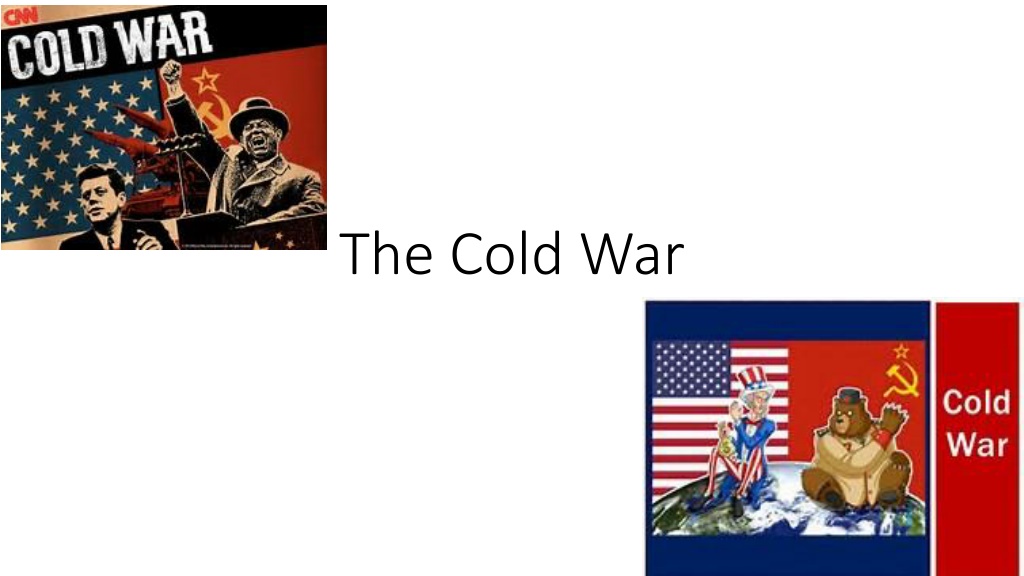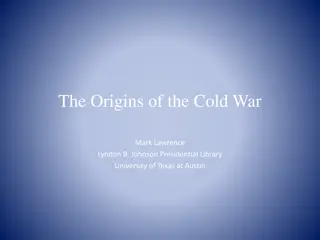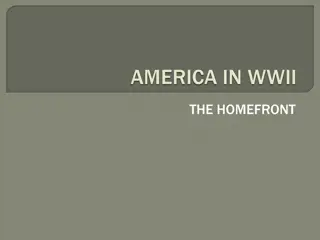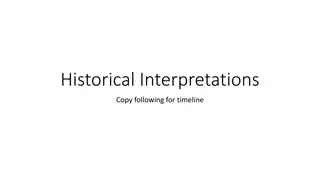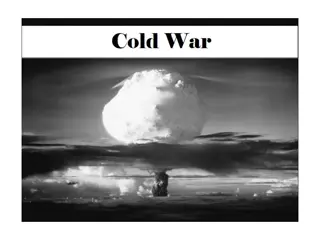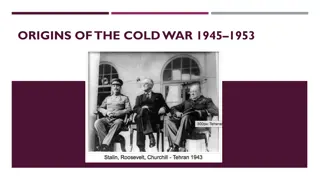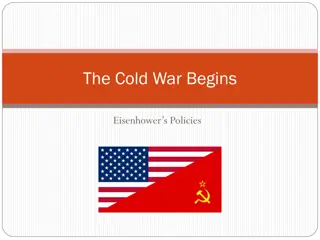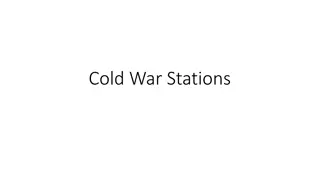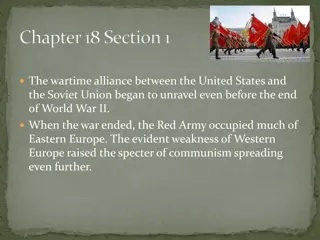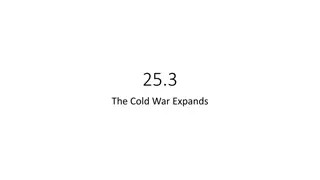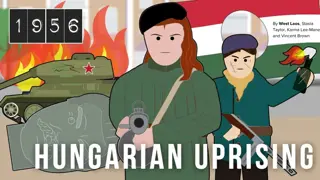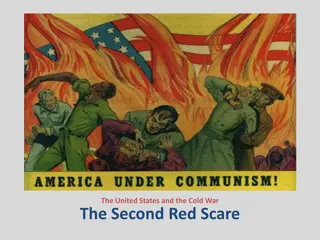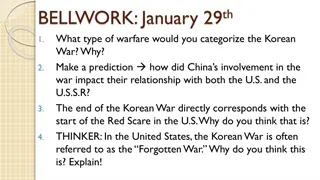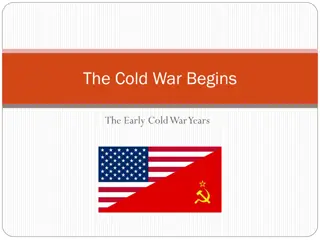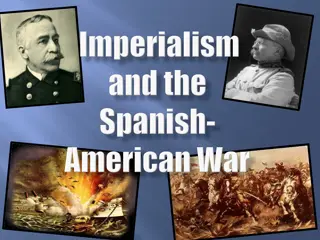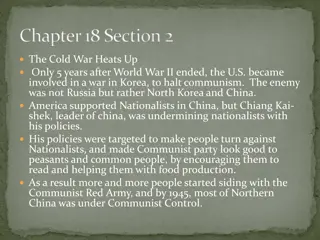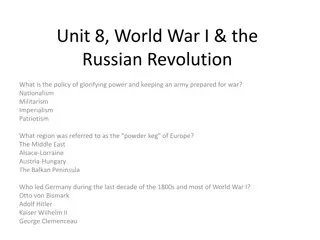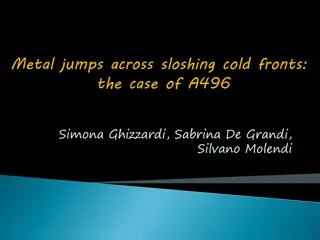Cold War Origins and Consequences
Tensions between the U.S. and Soviet Union, differing ideologies of capitalism, socialism, and communism, Iron Curtain division in Europe, and key events like the Berlin Airlift and Cuban Missile Crisis defined the Cold War era.
Download Presentation

Please find below an Image/Link to download the presentation.
The content on the website is provided AS IS for your information and personal use only. It may not be sold, licensed, or shared on other websites without obtaining consent from the author. Download presentation by click this link. If you encounter any issues during the download, it is possible that the publisher has removed the file from their server.
E N D
Presentation Transcript
SS5H5 The student will discuss the origins and consequences of the Cold War. a. Explain the origin and meaning of the term Iron Curtain. b. Explain how the United States sought to stop the spread of communism through the Berlin airlift, the Korean War, and the North Atlantic Treaty Organization. c. Identify Joseph McCarthy and Nikita Khrushchev. d. Discuss the importance of the Cuban Missile Crisis and the Vietnam War.
Build on What You Know You know that countries usually use armies to fight wars. After WWII, there was a new kind of war. Countries fought this war mostly with words and ideas.
Vocabulary Vocabulary Capitalism- individuals are free to own or work for a business of their choosing. Socialism- the government, consumers, and businesses control the economy. Communism- the government has complete power. Consumer- someone who buys something. Iron Curtain- an imaginary line that divided Eastern and Western Europe. Truman Doctrine- the promise to stop the spread of communism to countries that were not communist. Cease-fire- an agreement to stop fighting
How the Cold War Started Even before the end of World War II, tensions were building between the U.S. and the Union of Soviet Socialist Republics (U.S.S.R. or Soviet Union). The two countries had different ideas about government and economics and how the world should be run after WWII. The U.S. is a democratic republic, which is a type of government where we choose representatives to make laws. The economic system in the U.S. is known as a free enterprise or capitalism. In a free enterprise, individuals are free to own or work for a business of their choosing. Socialism spread throughout Europe after the war. In a Socialist system, the government owns major industries, such as banks, airlines, railroads, and power plants. People own stores, farms, and most factories. Together, government, consumers, and businesses control the economy. Communism is the system in which the government has complete power. The U.S.S.R. was run by a dictator and the people did not get to vote. The U.S. and other Western nations wanted to end communism. The U.S.S.R. wanted to spread it and then control all Communist countries.
Iron Curtain Iron Curtain Following Germany s defeat, the Allies divided the country. The US, Great Britain, and France governed sections of western Germany which became a free democracy. The USSR governed eastern Germany which became a communist state. The Allies also divided the German capital of Berlin even though it was in the Soviet sector of Germany. Winston Churchill described Europe as being divided by an Iron Curtain. On the west side of the Iron Curtain were the democracies of Western Europe and on the East side were the communist nations.
North Atlantic Treaty Organization In 1949, 12 allied nations signed a treaty in Washington D.C. These 12 allied nations founded the North Atlantic Treaty Organization (NATO) to support democracy. This organization was formed to stop the spread of communism. President Truman promised to help any country that the USSR tried to turn Communist. This policy was known as the Truman Doctrine, or the policy of containment.
Berlin Airlift Berlin Airlift Joseph Stalin wanted the western Allies out of Berlin. His army surrounded West Berlin and would not let any supplies in or out. Harry Truman responded with the Berlin Airlift. For several months in 1948-49, the US and its allies flew planes delivering supplies across the Soviet lines and into West Berlin. Not wanting a war, Stalin finally gave up. The Berlin Airlift only made the two sides angrier with one another.
Berlin Wall Berlin Wall The city of Berlin in Germany was divided at the end of WWII. The eastern part was under Soviet control. The western part was controlled by the Allies. Thousands fled from the eastern side to the west. In 1961, the Soviets built a wall to prevent people from leaving East Berlin and armed soldiers guarded the wall. People who tried to cross were killed. The Berlin Wall became the symbol of Communist dictatorship.
The Korean War The Korean War After WWII, the Allies split the East Asian nation of Korea in half. North Korea became a communist state. South Korea became a capitalist democracy. The 38th parallel served as a dividing line between the two nations. In 1950, North Korean troops crossed the 38th parallel and quickly conquered much of South Korea. The UN elected to send troops to stop the invasion. President Truman put General Douglas MacArthur in charge. MacArthur drove back the North Koreans. Before he could fully defeat them, Chinese troops crossed the border to help the North Koreans. The Korean War continued until 1953 and ended in a cease-fire
Joseph McCarthy Joseph McCarthy Joseph McCarthy was a US senator from the state of Wisconsin. During the 1950 s, he became convinced that Communists were trying to gain control of the US government. He vowed to find these Communists and drive them out. At first many US citizens backed him, but he went to far and accused high-ranking military officers of being Communists. When McCarthy tried to make his case on television, most people thought he came off looking cruel, paranoid, and perhaps crazy. The hearings on television ruined McCarthy s political career.
Nikita Khrushchev Nikita Khrushchev Nikita Khrushchev took over as First Secretary of the USSR s Communist Party after Joseph Stalin died in 1953. Under Khrushchev, the Soviet government was no longer a dictatorship. Khrushchev was a tough politician who distrusted the US. He tried to bully the US and its allies into leaving West Berlin in 1958.
Cuban Missile Crisis This was a 13 day confrontation between the U.S. and Soviet Union. A U.S. spy plane found missiles being stored in Cuba from the Soviet Union. The U.S. ordered a military blockade around Cuba to keep any more Soviet missiles from entering Cuba. After a period of tense negotiations, an agreement was met between John F. Kennedy and Nikita Khrushchev. The Soviets agreed to dismantle and send back the missiles from Cuba and the U.S. agreed to take out their missiles from Turkey and Italy.
Vietnam War Vietnam War By 1954, Vietnam had been divided into two parts. The Northern part was communist and the southern part was capitalist. At first the U.S. trained the South Vietnamese to fight the Communists. By 1963, there were about 17,000 American soldiers in Vietnam. By 1969, there were more than 500,000 U.S. troops in Vietnam. More than 58,000 American troops were killed during the war. In 1973, U.S. troops withdrew. South Vietnam fell to the Communists in 1975. The Vietnam War became very unpopular in the late 1960 s and early 1970 s. Vietnam was the first war in which citizens could actually see much of the death and destruction from a television. Many young people protested the war. This is one of the reasons the troops were removed.
